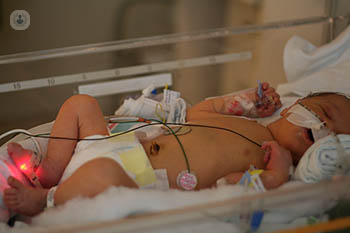Tracheoesophageal fistula (TOF)
What is tracheoesophageal fistula (TOF)?
Tracheoesophageal fistula, often abbreviated to TOF, is a birth defect that affects the oesophagus (the tube where food travels to the stomach), and the trachea (the windpipe). Tracheoesophageal fistula is where the lower oesophagus connects with the trachea, causing stomach acid to pass into the lungs, and air to pass from the trachea into the stomach.

What causes tracheoesophageal fistula?
The cause of tracheoesophageal fistula is not fully understood, and is not related to anything that happens during pregnancy. It only occurs in around one in 3500 to 5000 births, and can cause other problems such as with the development of the kidneys, problems with the bottom, and with other areas of the baby’s body, along with severe and even fatal pulmonary complications such as choking and pneumonia.
The defect occurs during the development of the oesophagus while the baby is in the womb, and is more common in babies whose mother had too much amniotic fluid during pregnancy (polyhydramnios).
How is tracheoesophageal fistula diagnosed?
The defect may be detected by the doctors before giving birth via an ultrasound scan. Your baby will be tested after birth, to see if there are any problems with swallowing or breathing.
Further testing will involve a tube being passed down the throat via the nose to see if it reaches the stomach, and an x-ray examination may be necessary.
What is the treatment for tracheoesophageal fistula?
A tracheoesophageal fistula will need to be repaired by surgery soon after birth. Using general anaesthetic, your baby will firstly be fed intravenously. The surgeons will make a cut on the right side of the chest, and closes the abnormal connection between the oesophagus and the trachea. The upper and lower sections of the oesophagus will then be joined.
Following the surgical procedure, your baby will need to be kept in intensive care, and in an incubator. Antibiotics, and pain medication will need to be given, and they will be connected to a machine to help them breathe and to drain fluids from their chest.
Your baby will be able to go home around two weeks after surgery, once he or she can take food by mouth.
What are the complications following tracheoesophageal fistula surgery?
There may be some complications that can arise following surgery, such as choking, difficulty swallowing and failing to gain weight.
The nurse and surgical team will explain the possible complications, and how they should be handled after you return home.
Most children requiring this kind of surgery will go on to live normal lives, but will need to be closely monitored for a while after surgery.

